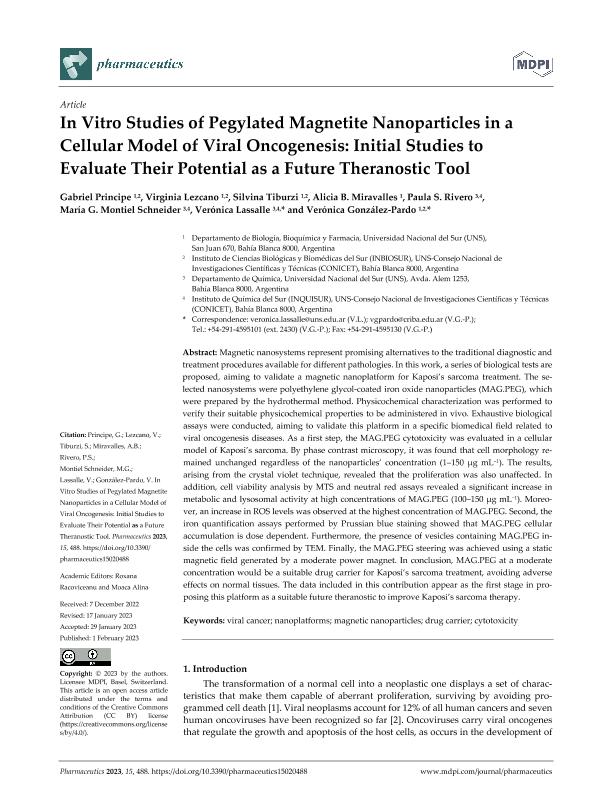Artículo
In Vitro Studies of Pegylated Magnetite Nanoparticles in a Cellular Model of Viral Oncogenesis: Initial Studies to Evaluate Their Potential as a Future Theranostic Tool
Principe, Gabriel ; Lezcano, Virginia Alicia
; Lezcano, Virginia Alicia ; Tiburzi, Silvina Mabel
; Tiburzi, Silvina Mabel ; Miravalles, Alicia Beatriz; Rivero, Paula Sofia; Montiel Schneider, María Gabriela
; Miravalles, Alicia Beatriz; Rivero, Paula Sofia; Montiel Schneider, María Gabriela ; Lassalle, Verónica Leticia
; Lassalle, Verónica Leticia ; González Pardo, María Verónica
; González Pardo, María Verónica
 ; Lezcano, Virginia Alicia
; Lezcano, Virginia Alicia ; Tiburzi, Silvina Mabel
; Tiburzi, Silvina Mabel ; Miravalles, Alicia Beatriz; Rivero, Paula Sofia; Montiel Schneider, María Gabriela
; Miravalles, Alicia Beatriz; Rivero, Paula Sofia; Montiel Schneider, María Gabriela ; Lassalle, Verónica Leticia
; Lassalle, Verónica Leticia ; González Pardo, María Verónica
; González Pardo, María Verónica
Fecha de publicación:
02/2023
Editorial:
Multidisciplinary Digital Publishing Institute
Revista:
Pharmaceutics
ISSN:
1999-4923
Idioma:
Inglés
Tipo de recurso:
Artículo publicado
Clasificación temática:
Resumen
Magnetic nanosystems represent promising alternatives to the traditional diagnostic and treatment procedures available for different pathologies. In this work, a series of biological tests are proposed, aiming to validate a magnetic nanoplatform for Kaposi’s sarcoma treatment. The selected nanosystems were polyethylene glycol-coated iron oxide nanoparticles (MAG.PEG), which were prepared by the hydrothermal method. Physicochemical characterization was performed to verify their suitable physicochemical properties to be administered in vivo. Exhaustive biological assays were conducted, aiming to validate this platform in a specific biomedical field related to viral oncogenesis diseases. As a first step, the MAG.PEG cytotoxicity was evaluated in a cellular model of Kaposi’s sarcoma. By phase contrast microscopy, it was found that cell morphology remained unchanged regardless of the nanoparticles’ concentration (1–150 µg mL−1). The results, arising from the crystal violet technique, revealed that the proliferation was also unaffected. In addition, cell viability analysis by MTS and neutral red assays revealed a significant increase in metabolic and lysosomal activity at high concentrations of MAG.PEG (100–150 µg mL−1). Moreover, an increase in ROS levels was observed at the highest concentration of MAG.PEG. Second, the iron quantification assays performed by Prussian blue staining showed that MAG.PEG cellular accumulation is dose dependent. Furthermore, the presence of vesicles containing MAG.PEG inside the cells was confirmed by TEM. Finally, the MAG.PEG steering was achieved using a static magnetic field generated by a moderate power magnet. In conclusion, MAG.PEG at a moderate concentration would be a suitable drug carrier for Kaposi’s sarcoma treatment, avoiding adverse effects on normal tissues. The data included in this contribution appear as the first stage in proposing this platform as a suitable future theranostic to improve Kaposi’s sarcoma therapy.
Palabras clave:
CYTOTOXICITY
,
DRUG CARRIER
,
MAGNETIC NANOPARTICLES
,
NANOPLATFORMS
,
VIRAL CANCER
Archivos asociados
Licencia
Identificadores
Colecciones
Articulos(INBIOSUR)
Articulos de INSTITUTO DE CIENCIAS BIOLOGICAS Y BIOMEDICAS DEL SUR
Articulos de INSTITUTO DE CIENCIAS BIOLOGICAS Y BIOMEDICAS DEL SUR
Articulos(INQUISUR)
Articulos de INST.DE QUIMICA DEL SUR
Articulos de INST.DE QUIMICA DEL SUR
Citación
Principe, Gabriel; Lezcano, Virginia Alicia; Tiburzi, Silvina Mabel; Miravalles, Alicia Beatriz; Rivero, Paula Sofia; et al.; In Vitro Studies of Pegylated Magnetite Nanoparticles in a Cellular Model of Viral Oncogenesis: Initial Studies to Evaluate Their Potential as a Future Theranostic Tool; Multidisciplinary Digital Publishing Institute; Pharmaceutics; 15; 2; 2-2023; 1-20
Compartir
Altmétricas



